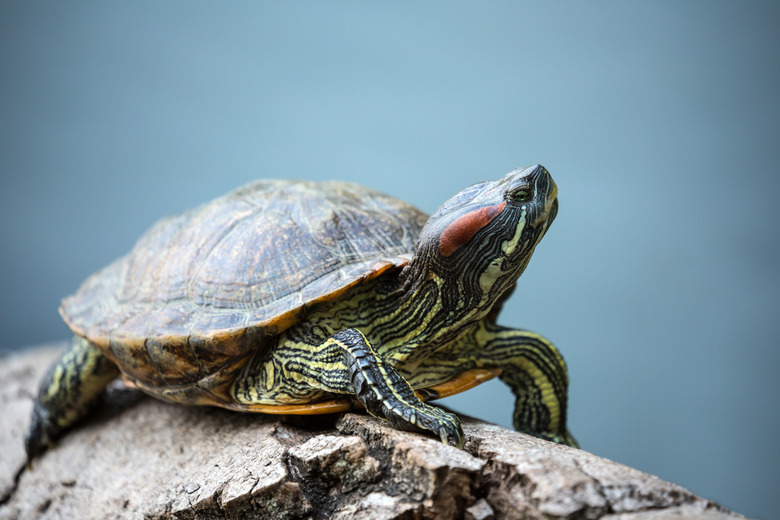Where Do Turtles Live & Lay Their Eggs?
Turtles are interesting animals. They're among the few creatures on earth that carry a home with them everywhere they go in the form of a shell that they can withdraw into. These reptiles have been around for millions of years and have had time to adapt to a wide variety of environments. Some turtles live in the ocean, some live in freshwater streams and rivers, and others live on land in forested areas. Where a turtle lives and breeds depends entirely upon the species of turtle.
TL;DR (Too Long; Didn't Read)
Where turtles live and how they breed depends entirely upon their species. Leatherback sea turtles live in the ocean and migrate thousands of miles to lay their eggs. Red-eared sliders live in rivers and lay their eggs close to where they live and eat. Box turtles live entirely on land and lay their eggs in moist soil in forests or marshlands.
Leatherback Sea Turtles
Leatherback Sea Turtles
Fully grown leatherback sea turtles can weigh in at a whopping 2,000 pounds, making them the heaviest turtles on earth. They are also the largest at an adult length of up to 7 feet. As their name implies, leatherback turtles have a tough leathery shell rather than a firm hard shell, and they live in the ocean. Which ocean? Almost all of them. Leatherbacks can be found in the Pacific, Atlantic and Indian oceans, giving them the widest distribution of any turtle species.
Leatherback turtles mate at sea but must lay their eggs on land. Female leatherbacks undertake the longest breeding migration of any turtle species, traveling up to 3,700 miles from their feeding grounds to the shore where they lay their eggs. Amazingly, females lay their eggs on the same shore where they themselves were born. It is a mystery how the turtles find this exact beach to return to.
Once a female leatherback turtle has reached her nesting site, she uses her strong back flippers to dig a shallow nest in the sand. There, she deposits between 75 and 80 eggs. She then covers the eggs with sand and heads back out to sea. Hatchling turtles emerge around 45 days later.
Red-Eared Sliders
Red-Eared Sliders
If you live in the U.S., you may have seen a red-eared slider. These turtles are common in the Midwestern United States and parts of the South. Even if you do not live in these areas, you may have seen red-eared sliders for sale in pet stores, as they are one of the most popular reptilian pets in North America.
Wild red-eared sliders are semi-aquatic turtles. Unlike sea turtles, red-eared sliders have clawed feet instead of flippers. However, their feet are webbed, which makes them fast in the water. Red-eared sliders are commonly found in freshwater streams and rivers, sunning themselves on rocks or hunting for prey such as small fish beneath the water's surface.
Red-eared sliders mate every year between March and July. Unlike sea turtles, female red-eared sliders do not return to a particular spot to lay their eggs. Instead, females search for a suitable place that is hidden from predators before digging a nest in the sand and depositing between two and 30 eggs. Female red-eared sliders do not watch over their eggs the way some other egg-laying animals such as birds do. Females return to the river, and their eggs hatch on their own about two months later.
Eastern Box Turtles
Eastern Box Turtles
Usually, turtlelike creatures that live entirely on land are referred to as tortoises. However, box turtles such as the eastern box turtle are an exception. They are part of one of the two "pond turtle" families, specifically the family Emydidae. Eastern box turtles cannot swim and will drown in deep water. However, they do usually live in moist areas in the Eastern United States such as marshlands and forests that receive frequent rainfall. Often, these turtles soak themselves in shallow puddles for days at a time.
Eastern box turtles have a large breeding window. They can reproduce any time from early spring to early fall. Females seek out a moist hidden patch of loose soil in which to dig their nests and deposit their eggs. These turtles are slow diggers, so creating a nest can take around six hours. Females lay between one and nine eggs at a time; they hatch 50 to 65 days later.
All turtle species share some common traits, but where they live and lay their eggs vary widely from species to species. Some turtles migrate to reproduce, while others never venture far from where they themselves were born.
Cite This Article
MLA
Cook, Maria. "Where Do Turtles Live & Lay Their Eggs?" sciencing.com, https://www.sciencing.com/do-turtles-live-lay-eggs-5954841/. 19 April 2018.
APA
Cook, Maria. (2018, April 19). Where Do Turtles Live & Lay Their Eggs?. sciencing.com. Retrieved from https://www.sciencing.com/do-turtles-live-lay-eggs-5954841/
Chicago
Cook, Maria. Where Do Turtles Live & Lay Their Eggs? last modified March 24, 2022. https://www.sciencing.com/do-turtles-live-lay-eggs-5954841/
